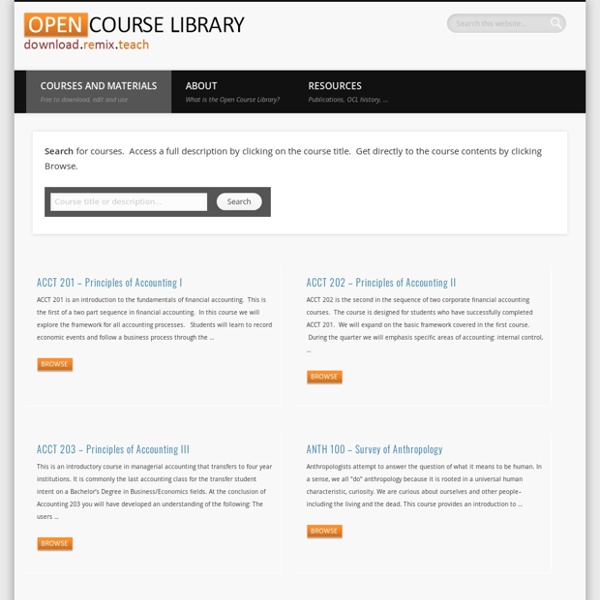



http://opencourselibrary.org/course/
Related: Free of Charge Educational Resources • Moodle12 Dozen Places To Educate Yourself Online For Free All education is self-education. Period. It doesn’t matter if you’re sitting in a college classroom or a coffee shop. Search Results Title: 10 for the Win!Grade: Kindergarten Overall Goal: To have students be able to count by multiples of 10 and comprehend the idea of a sequence of steps involved in a process. StandardsLearning ObjectiveAssessment5d Students understand how automation works and use algorithmic thinking to develop a sequence of steps to create and test automated solutions. K.NS.1: Count to at least 100 by ones and tens and count on by one from any number.Students will be able to program the beebots to go the correct distance.
25 Best Sites for Free Educational Videos RefSeek's guide to the 25 best online resources for finding free educational videos. With the exception of BrainPOP and Cosmeo, all listed sites offer their extensive video libraries for free and without registration. Academic Earth Thousands of video lectures from the world's top scholars. untitled El problema de definir aleatoriedad en las construcciones, es que, cuando el alumno guarda su contrucción para acabarla en otro momento (sin enviarla), al abrirla se vuelven a generar valores aleatorios. Esto puede ser una virtud (en contrucciones que no dependan de las condiciones iniciales), pero en general puede ser un problema. Por eso se hace necesario crear una nueva variable status (*), que canviará de valor de 0 a 1 y de 1 a 2, y sólo se calcularan valores aleatorios cuando esta variable sea igual a 1. Pero para que estos canvios sean efectivos se tienen que hacer "fuera" de GeoGebra, es decir, con código JavaScript Global. En la ventana de JavaScript Global (es una pestaña que aparece en las propiedades de cualquier objeto, y no está asociada sólo a ese objeto, sino a toda la construcción): function ggbOnInit() {
Open Educational Resources (OER): Resource Roundup Resources by Topic: OER, a part of the global open content movement, are shared teaching, learning, and research resources available under legally recognized open licenses -- free for people to reuse, revise, remix, and redistribute. Why are OER important? Moodle Nota del traductor: Esta documentación es sobre Restringir acceso para Moodle 2.9 y más recientes. Para versiones anteriores vea Usando actividades condicionales. Un ejemplo básico Los estudiantes tienen que realizar 4 actividades en un orden preciso, De acuerdo a su puntaje obtenido en un examen, la cuarta actividad - una lección de Moodle, - puede ser a un nivel inferior o a un nivel más avanzado. Search Engines:Free of Charge/Education From Topical Search Wiki K12 Education Main Page Search Engines:Free of Charge/Education/K-12
Moodle ¿Qué es ¡Sube de nivel! (Level up! ) ? ¡Sube de nivel! (Level up! Digital learning resources // National Film and Sound Archive, Australia NFSA Digital Learning combines the former Screen Australia Digital Learning websites and NFSA’s online education resources. These content rich education websites feature thousands of video and audio clips available for streaming and downloading. Twelve Canoes A portrait of the history, culture and place of the Yolngu people. Thunderbolt Kids Home Read a Book Meet the kids Science Adventures Comics